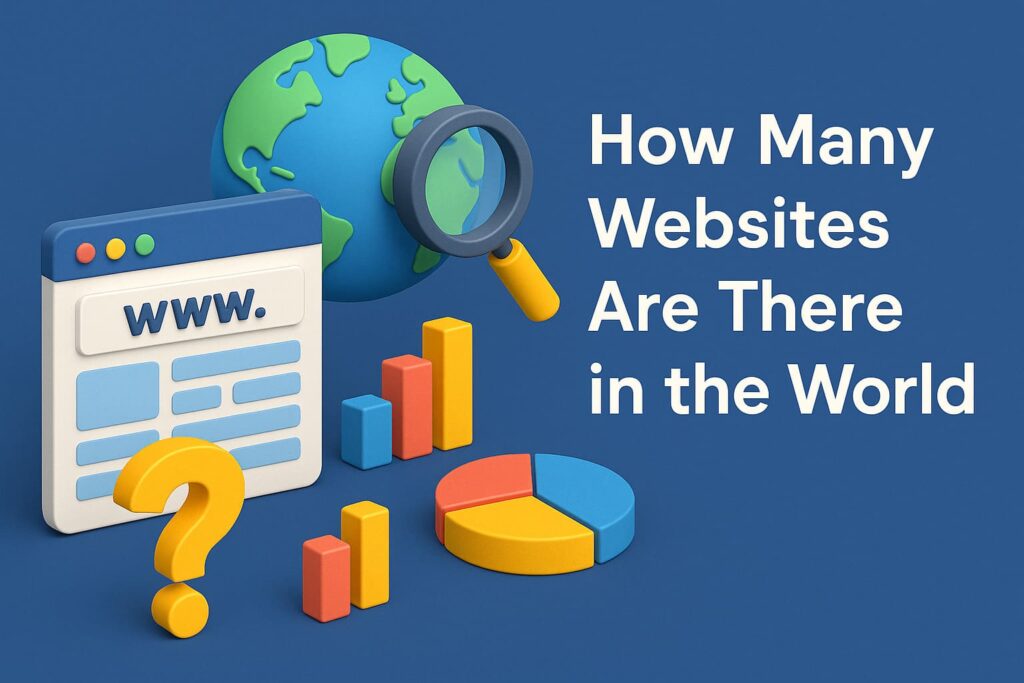The internet is like a massive city that never sleeps. It’s full of places to visit, shop, learn, and connect. But have you ever stopped to wonder just how big it really is? One way to wrap your head around it is by looking at the number of websites out there. In this blog post, we’ll explore everything from the total count to the most popular spots online. We’ll keep things simple and straightforward, so you can easily follow along. Whether you’re a curious browser or thinking about starting your own site, let’s dive in and see what the web looks like in 2025.
How Many Websites Are There?
Websites are the building blocks of the online world. They’re like digital homes where people share ideas, sell products, or just hang out. Right now, in September 2025, there are about 1.13 billion websites floating around the internet. That’s a staggering number—imagine more than one site for every seven people on the planet.
This count includes everything from big corporate pages to personal blogs. The number keeps growing because making a website is easier than ever. Tools like drag-and-drop builders let anyone create one without needing to code. Back in the early days, say 1991, there was just one website. By 2000, it jumped to around 17 million. Fast forward to 2010, and we were at over 200 million. Now, in 2025, we’ve crossed the billion mark, with growth slowing a tad but still adding millions each month.
Most of these sites are in English, but plenty use other languages like Chinese or Spanish. The exact number isn’t perfect because some sites are hidden or on private networks, but it’s a solid estimate based on tracking domains and hosts. Picture the web as an endless library—1.13 billion books, some read daily, others gathering dust.
How Many Active Websites Are There?
Having a website is one thing, but keeping it alive is another. Out of those 1.13 billion sites, only around 200 million are truly active. That’s roughly 18% of the total. An active site means it gets regular updates, fresh content, or steady visitors.
Why are so many inactive? People start projects with excitement but then move on. Businesses shut down, or domains expire without renewal. In 2025, active sites have seen a small uptick, thanks to more online shopping and social sharing. What makes a site active can vary—some define it by new posts within a year, others by traffic logs.
This difference highlights how much of the web is like abandoned buildings in that giant city. But the active ones are the heartbeat—they drive conversations, sales, and connections. If you’re running a site, remember to keep it fresh. Add new stuff, fix issues, and engage your audience to stay in the active club.
How Many Webpages Are There?
Websites are made up of pages, like chapters in a book. Counting every single webpage is tricky, but estimates put it in the trillions. Search engines like Google have indexed about 50 billion pages, but that’s just the tip of the iceberg. The real total is way higher because many pages are behind logins or not searchable.
Why so many? Big sites like online stores add new product pages daily. Wikis and forums grow with user contributions. Blogs pump out articles non-stop. Back in 2010, we thought there were about a trillion pages. Now, in 2025, it’s exploded thanks to more content creators and automated tools.
Think of webpages as leaves on trees in a vast forest. Most are in English, but global languages add diversity. Search engines crawl and store what they can, but the “deep web” hides even more. The surface we see is huge, and it’s growing every minute.
How Many Domains Are There?
Domains are the addresses of the web, like google.com or yourblog.net. As of mid-2025, there are about 370 million registered domains. That’s up a bit from last year, with .com leading the pack at over 160 million. Other popular ones include .net, .org, and country codes like .us or .cn.
The US tops the list for registrations, followed by China and Germany. New extensions like .app or .blog keep popping up, giving more options. People grab domains for new sites, investments, or just ideas. But not every domain has a full site—many are parked or redirect elsewhere.
This foundation keeps expanding as more folks go online. In 2025, growth is steady at around 1-2% yearly, fueled by businesses and creators. Without a domain, there’s no website, so this number tells us a lot about the web’s potential.
How Many Websites Are Created Every Day?
The internet doesn’t stand still—it’s buzzing with new additions. Every day, around 252,000 new websites go live. Break that down: that’s about 10,500 per hour or 175 per minute. Blink, and a few more appear.
This pace comes from easy tools that let beginners build sites quickly. Platforms handle the tech, so you focus on content. Businesses launch online stores, influencers start blogs, and hobbyists share passions. In 2025, this rate is holding strong, up slightly from previous years.
But not all new sites last. Many fizzle out without updates. Still, it shows the web’s vibrant energy. If you’re thinking of starting one, you’re joining a daily wave of creators shaping the digital world.
How Many Websites Are There in the US?
The US has been a web pioneer since the start. It hosts around 146 million websites, a big chunk of the global total. That’s because of strong tech scenes in places like Silicon Valley and a huge economy pushing online presence.
Compared to others, China has a similar number, with Europe following. US sites often reach worldwide audiences, especially in English. Many big names like Google and Amazon call it home. If you’re in the US, your site enters a crowded but opportunity-rich space.
How Many Websites Are Mobile-Friendly?
In 2025, phones are how most people surf the web. About 76% of websites are built to work well on mobile devices. They adjust layouts for small screens, making everything easy to tap and read.
This is key because over 62% of web traffic comes from mobiles. Search engines favor mobile-friendly sites in results. To make yours ready, use responsive designs that flex automatically. Test on different devices to catch issues.
Old sites that aren’t mobile-ready lose out on visitors. People bounce if pages load funny or buttons are tiny. Aim for mobile-first to keep up in this on-the-go world.
How Many Websites Are on Google?
Google is the main doorway to the web for most. It has indexed around 50 billion webpages, meaning they’re searchable. But not every site makes the cut—low-quality or spammy ones get skipped.
In 2025, Google handles billions of searches daily, guiding traffic. To get your site there, focus on good content and SEO basics. It’s the giant gatekeeper, holding over 90% of the search market.
Most Visited Websites in the World
Where do people spend their time online? In 2025, Google tops the list with about 98 billion monthly visits. YouTube comes next at 48 billion, followed by Facebook, Wikipedia, and Instagram.
These giants offer search, videos, social chats, and info. Locally, sites like Baidu shine in China. Visits are up overall, driven by mobile use and ads. Top spots rake in billions, showing the power of sticky content.
The Reasons for the Growth
The web didn’t get huge by accident. It started with Tim Berners-Lee’s invention in 1989 to share info easily. By the 1990s, browsers made it user-friendly. The 2000s brought faster connections and social media like Facebook in 2004.
Smartphones in 2007 changed everything, putting the web in pockets. Now, AI helps create content faster. With 5.56 billion internet users—68% of the world—the demand is massive. E-commerce booms, and events like pandemics pushed more online.
Future? Expect more with 5G, IoT devices, and virtual worlds. The web grows because it connects, entertains, and solves problems.
What Was the First Website?
The very first website went live on August 6, 1991. Created by Tim Berners-Lee at CERN, it was at info.cern.ch. It was simple text explaining the web itself—no images or fancy stuff.
You can still see a version today. It kicked off the hyperlinked world we know, changing how we share knowledge forever.
How Big Is the Internet Today?
Size-wise, the internet holds about 181 zettabytes of data in 2025. That’s a trillion gigabytes—mind-blowing. Daily, we create over 400 million terabytes from videos, posts, and more.
With 5.56 billion users and billions of devices, it’s a global network. But access isn’t equal; some areas lag. By year’s end, data could hit even higher. This fuels AI and cloud services, making the web an endless ocean of info.
Frequently Asked Questions
About 5.56 billion in 2025.
English leads at around 49%, followed by Chinese at 25%, Spanish at 8%.
Over 43% of sites.
Tim Berners-Lee.
Over 400 million terabytes.
.com with 160 million.
62%.
8.5 billion.
Around 26 million.
Up to 6 billion users by 2030.
These cover the basics and show the web’s scale.
Conclusion
The internet in 2025 is a powerhouse of 1.13 billion websites, with 200 million keeping things lively. From daily new additions to mobile shifts, it’s evolving fast. Whether you’re browsing or building, there’s room for everyone. If this sparked ideas, why not start your own site? Share your thoughts in the comments—what surprises you most about these numbers?
Also read:



